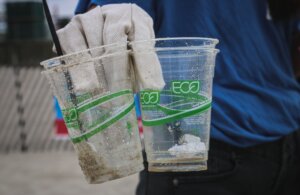A "gel pack" made of wood, left; a beer bottle made of wood fiber and paper eating utensils. (Courtesy Ranpak of the U.S., EcoXpac of Denmark and Hokuetsu of Japan)
Earlier this month more than 180 countries agreed to tougher rules for shipping non-recyclable plastic waste across national borders according to an article on asia.nikkei.com. This means more countries like Japan, the world’s second-biggest producer per capita of plastic waste after the U.S., will have to deal with their non-recyclables at home instead of shipping it to other countries.
It is a welcome shift for Japan’s paper industry, which has faced steadily shrinking demand. According to the Japan Paper Association, domestic demand shrank to 14.69 million tons in 2017 from 16.59 million tons in 2011. Manufacturers are now coming up with new ways to supplant plastic products in everything from straws to shampoo containers.
“The shift from plastic to paper will continue,” said Motoshi Muraoka, partner at NTT Data Institute of Management and Consulting. “It’s an unstoppable wave.”
Suppliers will have to move fast as retailers and other businesses close to the consumer move away from plastic.
Last July, coffee-chain giant Starbucks declared it would ban disposable plastic straws at all its stores by 2020. After the company’s announcement, McDonald’s, Legoland theme park operator Merlin Entertainment and other big hospitality brands switched to paper straws.
Nippon Paper Industries last year unveiled a paper straw prototype that it says solves old problems. Many paper straws have an odor that alters beverages’ flavor, and most have trouble standing up to the rigors of having liquid sucked through them. They get soggy, a drawback Nippon Paper has addressed with technology.
But cost is still an obstacle. Paper straws currently cost five to ten times more than their plastic counterparts at retail. Nippon Paper is working toward trimming production costs.
The company will also seek to commercialize a paper alternative to the pouches that hold refills of household detergents, soaps and shampoos. Up to now, container makers have shied away from paper products for kitchen and bathroom use due to the soggy factor.
Nippon Paper expects its Spops containers to replace refillable plastic and aluminum pouches. Spops containers are mostly cardboard, look a little like a milk carton and are designed as cartridges that can fit into and be removed from plastic dispensers. No scissors required.
Japan’s market for shampoo in refill pouches is estimated to be worth about 300 billion yen ($2.72 billion). Nippon Paper wants Spops to make up about 20% of that. It aims to get the cartons on the shelves by the end of the year.
The company is positioning the product as a growth driver in the digital era, which has been marked by receding demand for Nippon Paper’s flagship products, printing paper and newsprint.
And the growing demand for paper containers is creating opportunities elsewhere. Hokuetsu Package in October added a printing facility to its plant in Ibaraki Prefecture. It sells base paper to container makers after printing product names and patterns on the paper. Its existing facilities have mainly processed milk containers.
The new equipment has increased Hokuetsu Package’s printing capacity by just over 10%, allowing it to keep up with increased demand for other beverage and food containers as well as for paper trays.










